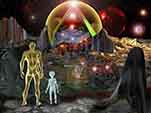Continuing with Richard Preston's work looking at these level 4 outbreaks. I find it disturbing and questionable that supposedly the natural host of these filo virus(Marburg,Ebola)has of yet not been located.
snip
.... ONE JULY 6, 1976, five hundred miles northwest of Mount Elgon, in southern Sudan, near the fingered edge of the central-African rain forest, a man who is known to Ebola hunters as Yu. G. went into shock and died with blood running from the orifices of his body. He is referred to only by his initials. Mr. Yu. G. was the first identified case, the index case, in an outbreak of an unknown virus.
Mr. Yu. G. was a storekeeper in a cotton factory in the town of Nzara. The population of Nzara had grown in recent years – the town had experienced, in its own way, the human population explosion that is occurring through the equatorial regions of the earth. The people of that area in southern Sudan are the Zande, a large tribe. The country of the Zande is savanna mixed with riverine forest, beautiful country, where acacia trees cluster along the banks of seasonal rivers. African doves perch in the trees and call their drawn-out calls. The land between the rivers is a sea of elephant grass, which can grow ten feet height. As you head south, toward Zaire, the land rises and forms hills, and the forest begins to spread away from the rivers and thickens into a closed canopy, and you enter the rain forest. The land around the town of Nzara held rich plantations of teak and fruit trees and cotton. People were poor, but they worked hard and raised large families and kept to their tribal traditions.
Mr. Yu. G. was a salaried man. He worked at a desk in a room piled with cotton cloth at the back of the factory. Bats roosted in the ceiling of the room near his desk. If the bats were infected with Ebola, no one has been able to prove it. The virus may have entered the cotton factory by some unknown route – perhaps in insects trapped in the cotton fibers, for example, or in rats that lived in the factory. Or, possibly, the virus had nothing to do with the cotton factory, and Mr. Yu. G. was infected somewhere else. He did not go to a hospital, and died on a cot in his family compound. His family gave him a traditional Zande funeral and left his body under a mound of stones in a clearing of elephant grass.
His grave has been visited more than once by doctors from Europe and America, who want to see it and reflect on its meaning, and pay their respects to the index case of what later became known as Ebola Sudan.
He is remembered today as a "quiet, unremarkable man." No photograph was taken of him during his lifetime, and no one seems to remember what he looked like. He wasn't well known, even in his hometown.
They say that his brother was tall and slender, so perhaps, he was, too.
He passed through the gates of life unnoticed by anyone except his family and a few of his co-workers. He might have made no difference except for the fact what he was a host.
His illness began to copy itself. A few days after he died, two other salaried men who worked at desks near him in the same room broke with bleeding, went into shock, and died with massive hemorrhages from the natural openings of the body. One of the dead men was a popular fellow known as P.G. Unlike the quiet Mr. Yu. G., he had a wide circle of friends, including several mistresses. He spread the agent far and wide in the town. The agent jumped easily from person to person, apparently through touching and sexual contact. It was a fast spreader, and it could live easily in people. It passed through as many as sixteen generations of infection as it jumped from person to person in Sudan. It also killed many of its hosts. While this is not necessarily in the best interest of the virus, if the virus is highly contagious, and can jump fast enough from host to host, then it does not matter, really, what happens to the previous host, because virus can amplify itself for quite a while, at least until it kills off much of the population of hosts. Most of the fatal cases of Ebola Sudan can be traced back through chains of infection to the quiet Mr. Yu. G. A hot strain radiated out of him and nearly devastated the human population of southern Sudan. The strain burned through the town of Nzara and reached eastward to the town of Maridi, where there was a hospital.
It hit the hospital like a bomb. It savaged patients and snaked like chain lightning out from the hospital through patients' families.
https://exploringrealhistory.blogspot.com/2019/09/part-2-hot-zoneebola-river.html






































